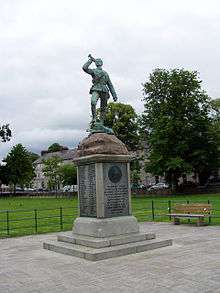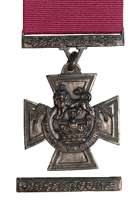Royal Irish Fusiliers
| Princess Victoria's (Royal Irish Fusiliers) Royal Irish Fusiliers (Princess Victoria's) | |
|---|---|
 Royal Irish Fusiliers Cap Badge | |
| Active | 1881–1968 |
| Country |
|
| Branch |
|
| Type | Infantry |
| Role | Line infantry |
| Size |
1–2 Regular battalions |
| Garrison/HQ | Gough Barracks, Armagh |
| Nickname(s) | The Old Fogs, The Rollickers |
| Motto(s) | Faugh-a-Ballagh (Clear the way) |
The Royal Irish Fusiliers (Princess Victoria's) was an Irish line infantry regiment of the British Army, formed by the amalgamation of the 87th (Prince of Wales's Irish) Regiment of Foot and the 89th (The Princess Victoria's) Regiment of Foot in 1881. The regiment's first title in 1881 was Princess Victoria's (Royal Irish Fusiliers), changed in 1920 to the Royal Irish Fusiliers (Princess Victoria's). Between the time of its formation and Irish independence, it was one of eight Irish regiments.
In 1968 the Royal Irish Fusiliers (Princess Victoria's) was amalgamated with the other regiments of the North Irish Brigade, the Royal Inniskilling Fusiliers and the Royal Ulster Rifles to become the Royal Irish Rangers.
Early history

The regiment was formed as part of the Childers Reforms by the amalgamation 87th (Prince of Wales's Irish) Regiment of Foot and the 89th (The Princess Victoria's) Regiment of Foot in 1881.[1] The regiment got its nickname, the Faughs, from their Irish war cry "Faugh A Ballagh" (Fág a' Bealach, meaning Clear the Way) from the Napoleonic Wars.[2] Regimental distinctions included a green plume worn on the left side of the headdress and an Irish harp as part of the badge.[2] It was the county regiment for Armagh, Monaghan and Cavan with its depot at Gough Barracks in Armagh.[3] Militarily, the whole of Ireland was administered as a separate command within the United Kingdom with Command Headquarters at Parkgate (Phoenix Park) Dublin, directly under the War Office in London.[4]
The 1st Battalion saw action in the Anglo-Egyptian War in 1882[5] and at the Battle of Talana Hill and the Relief of Ladysmith in October 1899 during the Second Boer War.[6] Meanwhile, the 2nd Battalion saw action at the Battle of the Tugela Heights in February 1900.[6]
The First World War
Regular Army
The 1st Battalion landed at Boulogne-sur-Mer as part of the 10th Brigade in the 4th Division in August 1914 for service on the Western Front[7] and suffered heavy losses at the Battle of Le Cateau in August 1914.[8] The 2nd Battalion landed at Le Havre as part of the 82nd Brigade in the 27th Division in December 1914 for service on the Western Front but moved to Salonika in December 1915 for service on the Macedonian Front before moving on to Egypt for service in Palestine in September 1917.[7]
The 3rd (reserve) Battalion fought against Irish rebels who were fighting to end British rule in Ireland and to establish the Irish Republic during the Easter Rising of 1916 in Dublin. Two of the Royal Irish Fusiliers were killed and six more wounded.[9][10]
New Armies

The 5th (Service) Battalion and 6th (Service) Battalion landed at Suvla Bay in Gallipoli as part of the 31st Brigade in the 10th (Irish) Division in August 1915 but moved to Salonika in October 1915 for service on the Macedonian Front.[7] The 7th (Service) Battalion, commanded by Lieutenant-Colonel Frederic Thornton Trevor Moore,[11] and 8th (Service) Battalion, commanded by Colonel John Southwell Brown,[11] landed in France as part of the 49th Brigade in the 16th (Irish) Division in February 1916 for service on the Western Front.[7] The 9th (Service) Battalion (County Armagh) landed at Boulogne-sur-Mer as part of the 108th Brigade in the 36th (Ulster) Division in October 1915 for service on the Western Front.[7]
Inter-War
With the independence of the Irish Free State in 1922 all the Irish line infantry regiments of the British army regiments were to be disbanded. However, this decision was later amended to exclude four battalions and after a successful campaign by the Royal Irish Fusiliers (Princess Victoria's) it was agreed that the disbandment would not be of the most junior regiment but of the two most junior battalions. These were the 2nd Battalion, Royal Irish Fusiliers, the old 89th Foot, and the 2nd Battalion, Royal Inniskilling Fusiliers, the old 108th Foot.[12]
The Second World War

The 1st Battalion, which had originally been serving with 25th Infantry Brigade in the 50th Division, was sent to France in early 1940 to join the rest of the British Expeditionary Force.[13] The battalion fought in the Battle of Dunkirk and were forced to be evacuated. After Dunkirk the battalion then became part of 210th Independent Infantry Brigade (Home) which was later renumbered 38th (Irish) Brigade.[14] The brigade was initially attached to the 6th Armoured Division and served with them during the start of the Tunisian Campaign until 2 February 1943 when they swapped with 1st Guards Brigade into the 78th Battleaxe Division.[14] They would remain with the division for the rest of the war, serving in the fighting in Sicily where the Irish Brigade fought, with great success, in the Battle of Centuripe in August 1943.[15] The success in Sicily was followed by the landings in the Italian mainland. During their service in Italy, the battalion took part in many river crossings and battles with perhaps the most famous being the Battle of Monte Cassino, one of the hardest-fought battles of the entire campaign and saw their final battle in Operation Grapeshot.[16]
The 2nd Battalion, formerly the 89th Regiment of Foot, served throughout the Siege of Malta from 1940 to 1943 with the 4th (Malta) Infantry Brigade, later renumbered 234th Infantry Brigade. The battalion was lost in the Battle of Leros in September 1943 and the Battle of Kos in October 1943 and had to be reformed later.[17]
Post-war
The 1st and 2nd battalions were amalgamated as the 1st Battalion in September 1948.[18] The regiment was deployed to Jordan in June 1949 and to Gibraltar in December 1949 before arriving at Border Barracks in Göttingen in November 1950.[18] It moved to Brooke Barracks in Berlin in June 1953 and then returned home in June 1964.[18] The regiment was deployed to Korea in July 1954 for service in the Korean War and to Kenya in January 1955 in response to the Mau Mau Uprising.[18] It went to Harding Barracks in Wuppertal in June 1956 and deployed to Libya in August 1958 before moving to Trenchard Barracks in Celle in October 1961.[18] It was sent on peace keeping duties to Cyprus in June 1964 before returning home in September 1965.[18] It deployed to Swaziland in April 1966 and to Aden in December 1966.[18] In July 1968 the Royal Irish Fusiliers (Princess Victoria's) was amalgamated with the other regiments of the North Irish Brigade, the Royal Inniskilling Fusiliers and the Royal Ulster Rifles to become the Royal Irish Rangers.[19]
Battle honours
The Regiment was awarded the following battle honours. Those shown in bold from the two World Wars were those selected to be emblazoned on the Kings's Colour:[20]
- From 87th Regiment of Foot: Monte Video, Talavera, Barrosa, Tarifa, Vittoria, Nivelle, Orthes, Toulouse, Peninsula, Ava
- From 89th Regiment of Foot: Egypt, Java, Niagara, Ava, Sevastopol
- Tel-el-Kebir, Egypt 1882 '84, Relief of Ladysmith, South Africa 1899-1902
- The Great War (14 battalions): Le Cateau, Retreat from Mons, Marne 1914, Aisne 1914, Armentières 1914, Hill 60, Ypres 1915 '17 '18, Gravenstafel, St. Julien, Frezenberg, Bellewaarde, Somme 1916 '18, Albert 1916, Guillemont, Ginchy, Le Transloy, Arras 1917, Scarpe 1917, Messines 1917 '18, Langemarck 1917, Cambrai 1917, St. Quentin, Rosières, Lys, Bailleul, Kemmel, Courtrai, France and Flanders 1914-18, Kosturino, Struma, Macedonia 1915-17, Suvla, Landing at Suvla, Scimitar Hill, Gallipoli 1915, Gaza, Jerusalem, Tell 'Asur, Megiddo, Nablus, Palestine 1917-18
- The Second World War: Withdrawal to Escaut, St Omer-La Bassée, Bou Arada, Stuka Farm, Oued Zarga, Djebel bel Mahdi, Djebel Ang, Djebel Tanngoucha, Adrano, Centuripe, Salso Crossing, Simeto Crossing, Malleto, Termoli, Trigno, Sangro, Fossacesia, Cassino II, Liri Valley, Trasimene Line, Monte Spaduro, Monte Grande, Argenta Gap, San Nicolo Canal, Leros, Malta 1940
Victoria Cross
Recipients of the Victoria Cross:

- Private Robert Morrow 1st Bn Royal Irish Fusiliers. 1915. Messines.[21]
- Lieutenant Geoffrey Cather 9th Bn Royal Irish Fusiliers. 1916. Hamel, Somme.[22]
Royal Irish Fusiliers Museum
The Royal Irish Fusiliers Museum is located on the Mall in Armagh, County Armagh, Northern Ireland. The exhibits include uniforms, medals, regalia and the two Victoria Crosses won by the regiment.[23]
Great War Memorials
- Irish National War Memorial Gardens Dublin.
- Ulster Tower Memorial Thiepval, France.
- Island of Ireland Peace Park Messines, Belgium.
- Menin Gate Memorial Ypres, Belgium.
- Helles Memorial Cape Helles, Gallipoli Peninsula, Turkey
References
- ↑ The London Gazette: no. 24992. pp. 3300–3301. 1 July 1881.
- 1 2 "A Tradition is Born - the Origin of the motto 'Faugh a Ballagh' and the Royal Irish Green Hackle". The Royal Irish. Retrieved 10 July 2016.
- ↑ "No pomp or ceremony as keys for Gough Barracks are handed back". News Letter. Retrieved 11 October 2014.
- ↑ Harris, pp. 2-3
- ↑ "Royal Irish Fusiliers (Princess Victoria's)". National Army Museum. Retrieved 10 July 2016.
- 1 2 "Royal Irish Fusiliers". Anglo-Boer War. Retrieved 10 July 2016.
- 1 2 3 4 5 "Royal Irish Fusiliers". The Long, Long Trail. Retrieved 11 July 2016.
- ↑ "The Battle of Le Cateau". British Battles. Retrieved 11 July 2016.
- ↑ Sinn Féin Rebellion Handbook. Irish Weekly Times. 1917. Retrieved 16 November 2010.
- ↑ "British soldiers KIA 1916 Rising". Irish Medals. Retrieved 16 November 2010.
- 1 2 "Royal Irish Fusiliers commanding officers". World War I Infantry commanding officers. Retrieved 18 July 2016.
- ↑ "2nd Battalion, The Royal Irish Fusiliers". Regiments.org. Retrieved 12 July 2016.
- ↑ Joslen, p. 272
- 1 2 Joslen, p. 373
- ↑ Doherty, p. 116
- ↑ "Operation Grapeshot and Operation Roast". World War II Database. Retrieved 10 July 2016.
- ↑ "Leros island falls, British troops captured as Churchill visits Malta". Times of Malta. Retrieved 10 July 2016.
- 1 2 3 4 5 6 7 "Royal Irish Fusiliers". British Army units 1945 on. Retrieved 15 July 2016.
- ↑ Corbally (1979), p. 61
- ↑ "The Royal Irish Fusiliers (Princess Victoria's)". Regiments.org. Retrieved 10 July 2016.
- ↑ "The Royal Irish Fusiliers Museum". Retrieved 10 July 2016.
- ↑ Lieut Geoffrey St. George Shillington Cather at Find a Grave
- ↑ "Royal Irish Fusiliers Museum". Army Museums. Retrieved 10 July 2016.
Sources
- Corbally, M J P M (1979). Outline History of The Royal Irish Rangers (27th (inniskilling), 83rd and 87th). Armagh: Royal Irish Rangers.
- Doherty, Richard (1993). Irish generals: Irish generals in the British Army in the Second World War. Appletree press. ISBN 9780862813956.
- Harris, Major Henry E. D. (1968). The Irish Regiments in the First World War. Mercer Press Cork. ISBN 978-0853420729.
- Joslen, Lt-Col H.F. (2003) [1960]. Orders of Battle: Second World War, 1939–1945. Uckfield: Naval and Military Press. ISBN 978-1-84342-474-1.
External links
| Wikimedia Commons has media related to Royal Irish Fusiliers. |
- Irish Brigade: The Story of the 38th (Irish) Brigade in the 2nd World War
- Department of the Taoiseach: Irish Soldiers in the First World War
